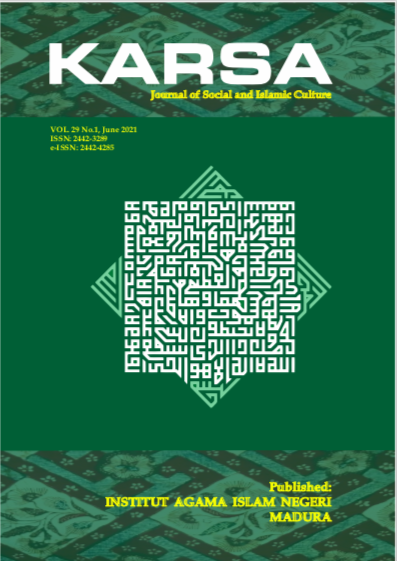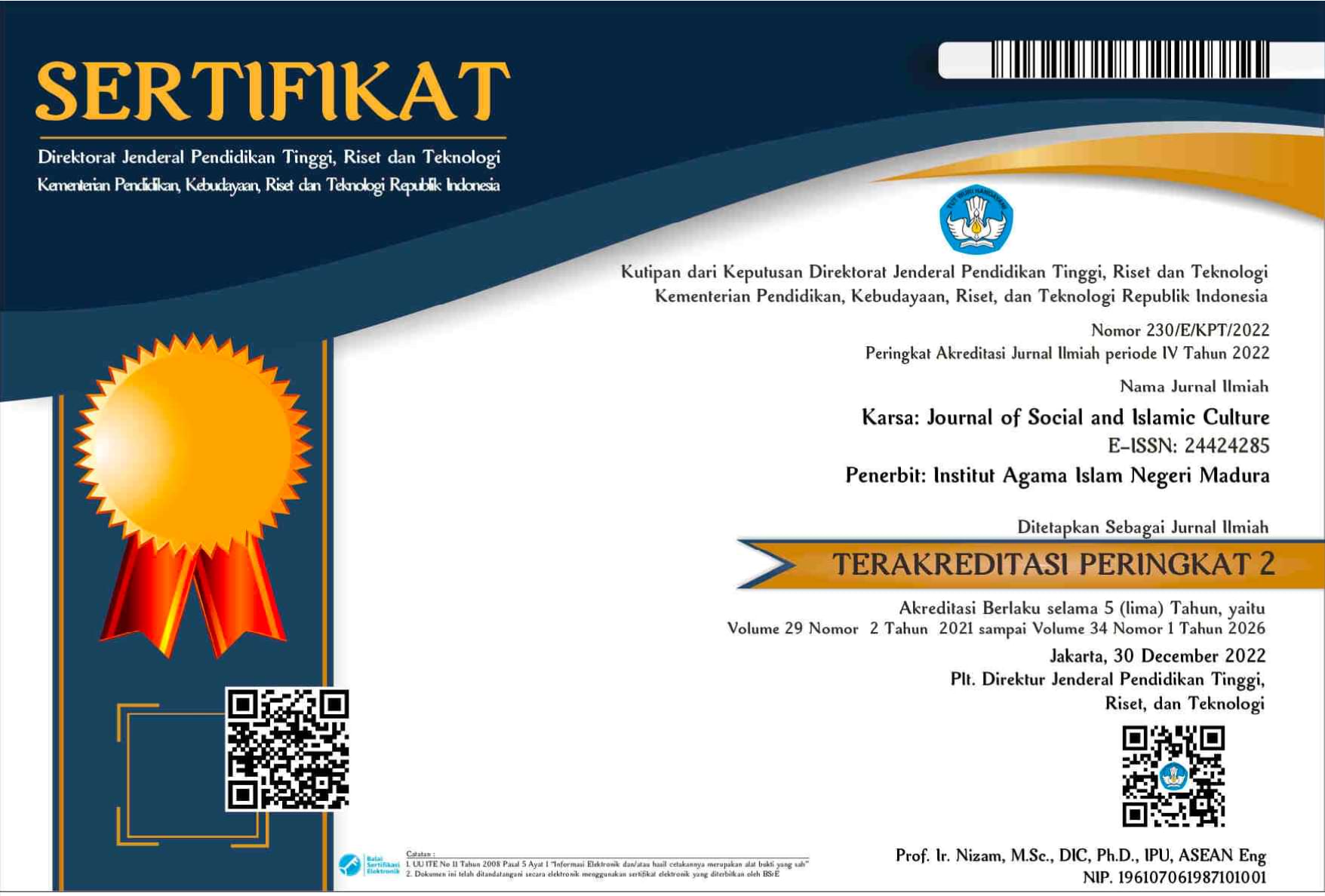Understanding Islamic Dialectics in The Relationship with Local Culture in Buton Architecture Design
 Abstract views: 707
,
Abstract views: 707
,
 PDF downloads: 481
PDF downloads: 481
Abstract
This study aimed to describe the shape and meaning of the architectural design of the Buton house both from an emic and ethical perspective. The focus of the problem was: (1). What was the shape and pattern of the house layout of the Butonese people? (2). What was the meaning of the traditional house architecture of the Butonese people? The data were obtained through a series of interviews, non-participant observation, and document review. All data were analyzed through some stages: formulation of questions, making descriptive narratives, data reduction, application, and interpretation, then concluding. Based on an analysis of the research problem, the following conclusions were obtained: (1). The shape of the Buton house had an aesthetic meaning related to belief or the dimension of religiosity, in this case, Islam; (2). The patron or pattern of the Butonese house building had become part of their system of thinking, so that eventually it became something standards, such as the standard of spatial structure, shape, structure, and ornamentation. In subsequent developments, there appeared to be an internal effort by the Butonese to provide a new perspective on the meaning of the Buton house, leading to interpretations oriented to Islamic values. The form of houses on stilts as depicted in malige and kamali by the local community was interpreted as a replica of a Muslim performing the prayer ritual. The model of a tiled roof was analogous to the composition or position when he was praying, where the place of the right hand was above the left hand. Whereas in the perspective of political power, the tiled roof was a symbol of political and religious unity. Pineapple ornaments played a role as a symbol of monotheism. This symbol also is a manifestation of the religious ethics Butonese, who always direct their life to the values of monotheism.
Downloads
References
Alhamuddin, Alhamuddin. “Abd Shamad Al-Palimbani’s Islamic Education Concept: Analysis of Kitab Hidayah Al-Sālikin Fi Suluk Māsālāk Lil Muttāqin.” Qudus International Journal of Islamic Studies 6, no. 1 (Februari 2018): 89-102. https://doi.org/ 10.21043/qijis.v6i1.3717.
Alifuddin. Islam Buton (Interaksi Islam dengan Budaya Lokal). Jakarta: Balitbang Depag RI, 2006.
Alifuddin, Muhammad, Alhamuddin, and Nurjannah. “School of Anak Laut (Sea Children): Educational Philanthropy Movement in Bajo Community of Three-Coral World Center.” Jurnal Iqra’: Kajian Ilmu Pendidikan 6, no. 1 (2021): 164-79. https://journal. iaimnumetrolampung.ac.id/index.php/ji/article/view/1057.
Andjo, Nur Ikhsanuddin. Rumah Adat Buton. Majalah Budaya Buton edisi II. Kendari: Yayasan Wolio Molagi, 1999.
AS, Zulkarnain and Andi Hildayanti, “Integrasi Konsep Arsitektur Islam pada Rumah Adat Saoraja Lapinceng di Kabupaten Barru.” NATURE: National Academic Journal of Architecture 5, no. 1 (2018): 1-12. https://doi.org/10.24252/nature.v5i1a1.
Barliana, M. Syaom. “Perkembangan Arsitektur Masjid: Suatu Trans-formasi Bentuk dan Ruang.” HISTORIA: Jurnal Pendidik dan Peneliti Sejarah 9, no. 2 (Desember 2008): 45-60, https:// ejournal.upi.edu/index.php/historia/article/view/12171.
Dewi, Ni Ketut Agustina. “Wantah Geometri, Simetri, dan Religiusitas pada Rumah Tinggal Tradisional di Indonesia.” Jurnal Permu-kiman Natah 1, no. 1 (2003): 29-43. https://ojs.unud.ac.id/index. php/natah/article/view/2923.
Gay, L. R., and Peter W. Airasian. Educational Research, Competencies for Analysis and Application (Sixth Edition). New Jersey: Prentice-Hall Inc., 2000.
Heryati, Heryati and Nurnaningsih Nico Abdul. “Kearifan Lokal pada Arsitektur Vernakular Gorontalo: Tinjauan pada Aspek Budaya dan Nilai-Nilai Islam.” EL-HARAKAH: Jurnal Budaya Islam 16, no. 2 (Desember 2014): 151-173, https://doi.org/10.18860/el. v16i2.2774.
Hidayatun, Maria. Hakekat Ruang dalam Arsitektur Tradisional Sebagai Satu Bentuk Jawaban dari Tantangan Alam (Studi Tentang Arsitektur Tradisional Vernakular). Surabaya: Fakultas Teknik Universitas Petra, 2008.
Kementerian Agama. Al-Qur’an dan Tafsirnya. Jakarta: Kementerian Agama RI, 2010.
Koentjaraningrat. Pokok-Pokok Antropologi Sosial. Jakarta: Dian Press, 1985.
Miles, Matthew B., and A. Michael Huberman. Qualitative Data Analysis: A Sourcebook of New Method. Beverly Hills: Sage Publication, 1986.
Moustakas, Clark. Phenomenological Research Methods. London: Sage Publications, 1994.
Tarigan, Riandy. “Membaca Makna Tradisionalitas pada Arsitektur Rumah Tradisional.” Jurnal Arsitektur Komposisi 12, no. 3 (2019): 199-210. https://ojs.uajy.ac.id/index.php/komposisi/arti cle/view/2202.
Subarna, Abay D. Diskusi Ilmiah Arkeologi. Jakarta: Depdikbud, 1987.
Sutrisno, Muji and Hedar Putranto. Teori-Teori Kebudayaan. Yogyakarta: Kanisius, 2005.
Tono, Sidik, M. Roem Syibly, Amir Mu’allim, Ahmad Nurozi, and Muhammad Roy Purwanto. “The Harmonious Relationship between Minangkabau Custom and Islam in the Distribution of Inheritance.” Al-Shajarah: Journal of the International Institute of Islamic Thought and Civilization 24, Special Issue: Shariah and Law as Catalysts for Global Peace (2019): 39-55. https://journals. iium.edu.my/shajarah/index.php/shaj/article/view/931.
Umar, Muhammad Zakaria. “Koeksistensi Konsep Makna Simbolik Rumah Tradisional Buton (Rumah Kaum Maradika) dengan Kantor BKDD di Kota Baubau,” Jurnal Teknik: Jurnal Mustek Anim HA 5, no. 1 (2016): 17-29. http://ejournal.unmus.ac.id/ index.php/mustek/article/view/487.
Umar, Muhammad Zakaria and Muhammad Arsyad. “Koeksistensi Konsep Makna Simbolik Rumah Kaum Kaomu (Malige) dengan Kantor Dispenda Kota Baubau.” Jurnal Arsitektur, Bangunan, & Lingkungan 6, no. 2 (Februari 2017): 37-46. https://publikasi. mercubuana.ac.id/index.php/virtuvian/article/view/1399.
Yahya, Aulia. “Arsitektur Islam: Seni Ruang Dalam Peradaban Islam.” November 4, 2008. https://auliayahya.wordpress.com/2008/11/ 04/arsitektur-islam-seni-ruang-dalam-peradaban-islam/.
The journal operates an Open Access policy under a Creative Commons Non-Commercial Share-Alike license. Authors who publish with this journal agree to the following terms:
- Authors retain copyright and grant the journal right of first publication with the work simultaneously licensed under a Creative Commons Attribution License that allows others to share the work with an acknowledgement of the work's authorship and initial publication in this journal.
- Authors are able to enter into separate, additional contractual arrangements for the non-exclusive distribution of the journal's published version of the work (e.g., post it to an institutional repository or publish it in a book), with an acknowledgement of its initial publication in this journal.
- Authors are permitted and encouraged to post their work online (e.g., in institutional repositories or on their website) prior to and during the submission process, as it can lead to productive exchanges, as well as earlier and greater citation of published work.





















